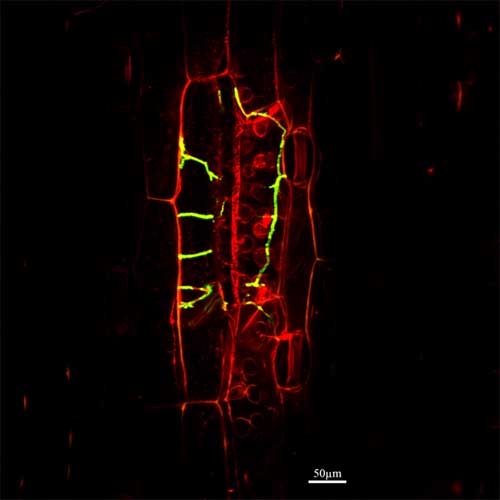Stopping the benign microbes all around us becoming pathogenic to plants
Published on 1 December 2010 in Sustainability and Communities
Introduction
Pathogens of plants and animals can be present on crop plants with no visible symptoms. New evidence from molecular detection methods is revealing that many microorganisms enter several different relationships with plants during their life cycles. Organisms that we know as plant pathogens such as Rhynchosporium secalis, our most problematic disease of barley called ‘rhynchosporium’, can also complete its life cycle (both on susceptible and resistant barley) undetected and without symptoms. Other disease-causing organisms may even be beneficial to their host plant if they don’t receive a trigger or signal that causes them to become pathogenic.
Genome sequencing, together with traditional epidemiology, have shown that pathogens such as Pectobacterium atrosepticum, the causal agent of ‘blackleg’ on potato, are simply opportunists. They produce proteins that allow them to adhere to roots and even those involved in nitrogen-fixation. Such pathogens are found routinely on the roots of brassicas and other crop and weed plants, where they are either benign or perhaps beneficial to their host. By comparing genomes from many bacteria, it seems that the genes involved in both disease and other plant-associated life styles are relatively easily transmitted between species, facilitating these opportunistic relationships between plant host and microbe.
Key Points
Understanding the ecological relationships of microbes has several important implications:
- Crop cycles (rotations) can inadvertently cause either build-up or decline of potential pathogens.
- Many organisms have the potential to become pathogens given appropriate changes in crops or climate.
- Breeding for resistance is normally only against symptoms. Non-symptomatic growth might be present and could cause either yield loss or even benefit to the host plant.
- Controlling a visible pathogen with, for example fungicides, may also kill undetected beneficial microbes.
Why should we be concerned? Because not only is the soil, and especially the root environment, a very rich and complex community of microbes, but so too is the leaf environment, with vast numbers of fungi and bacterial species. Many of these are unculturable but both survive and multiply on plants. Some of the bacteria that have the ability to colonise plants include both animal and human pathogens such as toxic Escherichia coli and Salmonella. Successful colonisation depends in part on how they interact with the native species: while some plant microbes promote their growth, others can limit their numbers. Therefore we need to know much more about the ecology of these organisms in the environment so that new practices for utilisation of, for example, farm and municipal waste on agricultural land, can be developed safely and successfully.

Figure 1: Green fluorescent protein markers (GFP) reveals presence of stealthy pathogen
Barley leaf with symptomless infection and sporulation by Rhynchosporium secalis 10 days after inoculation with a GFP-expressing isolate. These spores may spread the pathogen to new plants even though no disease is visible. [Image produced by Amar Thirugnanasambandam.]
Research Undertaken
In natural ecosystems epidemics are the exception, whereas without effective modern crop protection practices, epidemics would be common in our high input, modern western European agricultural practice. Our research is showing us how organisms become pathogens, helping us to both develop our modern crop protection practices, and to change our farming approaches so that we can lessen the pressures leading to potential epidemics and the selection of new pathogens. A key to achieving this is the use of more crop diversity and improving its deployment, as well as the more effective targeting of pesticides to prevent the removal of beneficial organisms. Another key is the development of broad spectrum resistance in our crops, using multiple mechanism to defeat pathogens which can evolve very quickly.
We have known for many years that a detailed understanding of the mechanisms of pathogenicity is essential for all these objectives. However, we will be more successful in applying this knowledge as we begin to appreciate better that pathogenicity is only part of the life cycle for some microbes. A major part of the battle between plant and pathogen can be won by understanding plant-microbial ecology in addition to the direct defence confrontation of pathogens and their hosts. This may be achieved by reducing inoculum of the potential pathogen directly or by increasing its competitors and/or antagonists. Either way it is about managing the microbial community away from the centre of confrontation where the pathogen dominates. Elimination of the pathogen will always be difficult. Now we are beginning to appreciate that such pathogens may often be a part of the normal or even beneficial ecology of the environment, so we should keep them there in a benign, beneficial or symptomless state.
Policy Implications
As EU regulations remove fungicides from the market, we need to more effectively target those remaining at appropriate times on appropriate varieties. This will reduce usage overall but give better yield response. Less crop loss to disease increases efficiency, effectively reducing the carbon footprint of our crops. More yield for a given level of input means less carbon input from fertilisers per tonne of crop, contributing to climate change mitigation.
Crops that remain resistant (durable resistance) are the most cost-effective way to control disease, so we should continue to enhance our understanding of the mechanisms both at the molecular and the ecological level on farm to achieve that for the crops important for our rural economy, contributing to climate change adaptation.
Author
Adrian C. Newton, Ian K. Toth, Nicola J. Holden Adrian.Newton@scri.ac.uk
Topics
Sustainability and Communities







